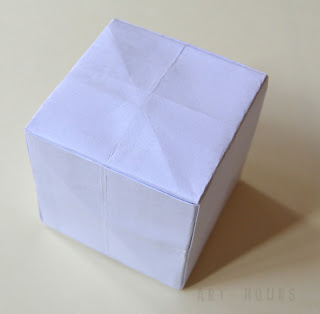We have often seen or heard the word Modular Origami. Do you know what it really is?
Let's have a brief glimpse on Modular Origami today.
Let's have a brief glimpse on Modular Origami today.
 |
| Modular Origami with Polyhedrons |
When you google on the internet on modular origami, you will find various versions and answers. So here we go....
What is Modular Origami?
Modular Origami or Unit Origami is a paper folding technique which uses two or more sheets of paper to create a larger and a more complex structure that would not be possible using single-piece origami techniques. Each individual sheet of paper is folded into a module or a unit, and then these modules are assembled into a flat shape or 3D structure by inserting the flaps into pockets created by the folding process. Assembling them requires no glue or thread.
What holds the model together?
The insertions create tension or friction that holds the model together.
Historical Evidence:
If you want to know the history then there's a lot of information on the net on that too. However, the first historical evidence for a modular origami design comes from a Japanese book by Hayato Ohoka published in 1734 called Ranma Zushiki.
Some of the most Popular Modular Origami designers include:
Misonobu Sonobe, Tomoko Fuse, Kunihiko Kasahara, Miyuki Kawamura, David Mitchell, Heinz Strobl and yes, I was immensely pleased to find an Indian name on the list: Meenakshi Mukherjee.
There are several traditional Japanese modular origami designs. The modular origami forms may be flat or 3-D. The flat forms are usually polygonal forms, stars, rotors or rings while the 3-D forms tend to be regular polyhedra or tessellations of simple polyhedra. They have been named after the person who designed and first folded them.
Modular origami techniques have been used to create boxes with lids, containers etc. Tomoko Fuse is a name synonymous with modular origami boxes. If you happen to find then there's a book called 'Fabulous Origami Boxes' by Tomoko Fuse.
Modular origami techniques have been used to create boxes with lids, containers etc. Tomoko Fuse is a name synonymous with modular origami boxes. If you happen to find then there's a book called 'Fabulous Origami Boxes' by Tomoko Fuse.
To keep it simple and short, Modular Origami is a two staged paper folding technique, which uses multiple sheets of paper. The first stage is to fold individual sheets of paper into identical modules or units. In the second stage, the modules are assembled into an integrated flat shape or a 3-D structure.
Some people love modular origami while some do not like the idea of folding the same units a number of times. It all boils down to the fact that you need to have a fair amount of patience and love for the art of folding.
Here is a teeny-weeny glimpse of some modular flat origami forms designed by different people from around the world and folded by me, to understand and explain the concept of Modular Origami better to all of you out there.
The above beautiful 8-point modular origami star is fairly simple to fold and requires minimal patience. I am not sure as to who originally designed it but discovered this star's diagram that was made by Fumiaki Shingu.
This requires 16 units to be assembled together. It is easy to assemble the modular units but requires a lot of patience since you have to keep folding 16 similar units.
Some people love modular origami while some do not like the idea of folding the same units a number of times. It all boils down to the fact that you need to have a fair amount of patience and love for the art of folding.
Here is a teeny-weeny glimpse of some modular flat origami forms designed by different people from around the world and folded by me, to understand and explain the concept of Modular Origami better to all of you out there.
 |
| The 8-pointed Modular Origami Star |
 |
| 16-point Modular Origami Star |
 |
| Traditional Ninja Star |
 |
| The Rotor/Frisbee - Designed by Francisco Caboblanco |
 |
| 8-point Star - Designed by Tomoko Fuse |
Now let's have a look at the 3-D structures/polyhedrons possible using Modular Origami. Again, these have been designed by different people and accordingly named after the designer.
 |
| From L to R : Tricorne, Triangular pyramid, Triangular Boxes |
 |
| From L to R: The Sonobe Cube and The Japanese Menko |
 |
| The Jackson Cube |
The above examples I have cited are just some small examples of Modular Origami. There are a plethora of possibilities with Modular Origami. I hope this article helps you initiate and explore the world of Modular Origami.
---

No comments:
Post a Comment